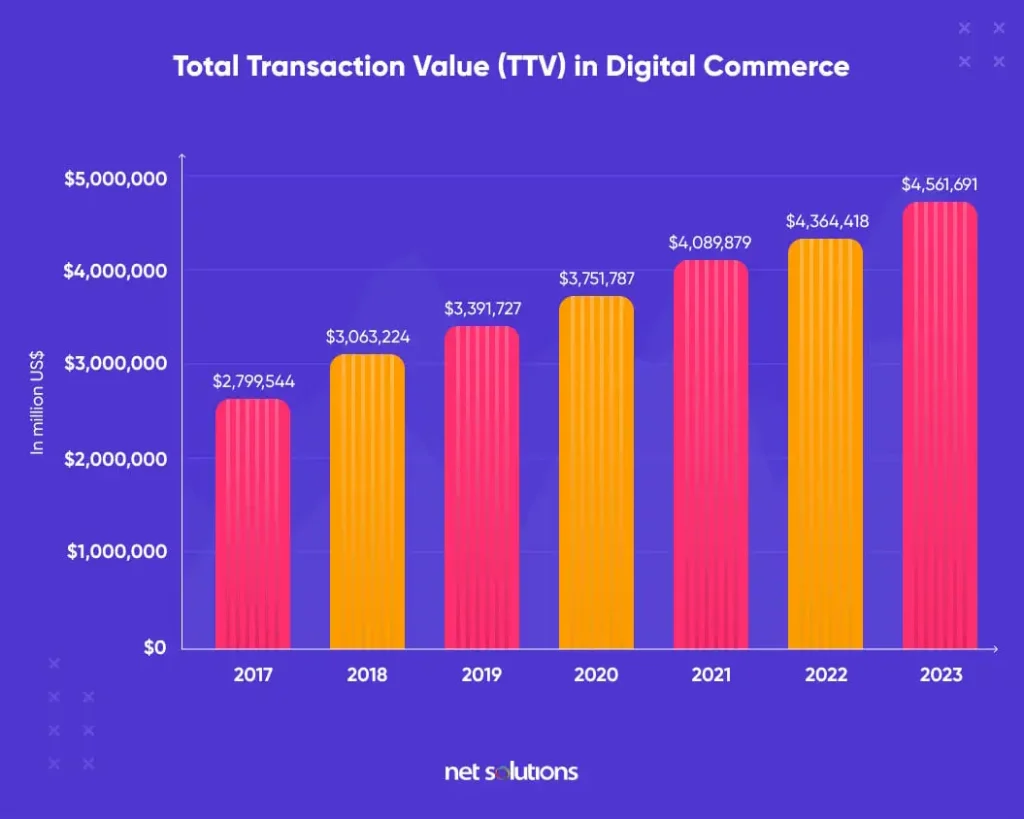Entrepreneurs need intelligent digital retail practices to address eCommerce challenges in this highly competitive world. Read about 10 such eCommerce challenges you need to overcome to emerge as a leader in the eCommerce space.
An eCommerce store is the key retail growth engine for any business, and eCommerce is expected to hold 17% of the industry by 2022. The growth witnessed by digital commerce over the last decade has also given several eCommerce challenges. Getting on to the digital commerce wave is not easy with the increasing size and demand for online business.
Nearly 81% of shoppers start their journey with online research. 71% of the customers agree that a fast and highly responsive online marketplace is crucial for a satisfactory shopping experience.
The worth of the Total Transaction Value (TTV) in the digital commerce segment is expected to stand at USD 4.5 million by 2023. Leaders must first address eCommerce businesses’ core challenges to achieve a competitive edge in this crowded marketplace.

eCommerce Business Challenges and Solutions
Leaders across the globe face several eCommerce challenges while adapting to the digital commerce business. The ten most common eCommerce challenges and solutions when building a successful eCommerce platform are here.
1. Customers’ Exploding Expectations
Retailers worldwide are continuously trying to build their reputation and a sharp brand image with the promise of a great experience. It is challenging to match customer expectations in an era where experience matters the most, and tech giants like Amazon take the online buying process to the proverbial ‘next level’ with anticipatory shipping methods. Competing with these giants and matching the ever-evolving customer demands is a huge challenge for retailers today. 86% of buyers are likely to give extra money for a better experience, with a more significant 89% starting their own business and turning into competitors due to a poor experience.
Solution
To meet customer expectations for a user experience, brands should start analyzing their eCommerce trends and focus on using this data to develop personalized customer experiences. The customers must feel acknowledged and valued right from the moment they start using your service. Send them notification alerts or product updates to facilitate this customer connection.
2. Agility Challenge

We can define Agility as the capability of a business to introduce advancements, develop and deploy digital content, and respond to seasonal changes rapidly. Agility drives immediate digital fulfillment, and it is identified as one of the most critical initiatives in eCommerce businesses. Agile transformation is at the heart of the digital business, and scaling is essential for making it successful.
Many companies find it difficult to move or change quickly to adapt to customers’ needs. This is because they cannot integrate new technologies efficiently with their existing system, and, as a result, penetration into the market gets more complicated.
Solution
Being agile in the eCommerce approach helps businesses deliver an enhanced shopping experience. To be agile, eCommerce businesses must assimilate quick changes across all platforms and create personalized collections that inspire consumers. They should keep putting out fresh content.
3. Being Consistent

Consistency is an essential element when curating a successful omnichannel strategy. Customers use numerous platforms to search for items before deciding, requiring businesses to provide smooth buying touchpoints through every product or service. However, analyzing and understanding customer interactions across all touchpoints and using them to build a consistent and smooth customer experience is one of the significant eCommerce challenges for retailers.
Solution
Brands can optimize their online platforms to deliver complete consistency between search options, various shopping pages, and shipping details. This will help them make the shopping experience seamless and satisfactory for the shoppers. They should also work on product quality, fulfillment, and distribution.
4. Data Security

Building strong ecommerce security is critical to your company’s success. The increased use of eCommerce raises security concerns, and this is one of the most pressing eCommerce issues. Hackers and fraudsters threaten to attack the host server, steal confidential data, and introduce viruses.
Breach of credit and debit card information has become commonplace, and such lapses directly impact a consumer’s trust. Phishing is another threat hackers pose as a company and request sensitive information from their customers. Several users are increasingly concerned about the ability of eCommerce websites to protect their identity and transaction details effectively.
Solution
To maintain the brand’s reputation and attract repeat customers, every business operating in the digital space must prioritize security. Switching to HTTPS protocols, using credible third-party payment processing systems, and obtaining Payment Card Industry Data Security Standard (PCI DSS) accreditation are steps to protect the business’s data and its customers. Firewall software and plugins that protect against SQL injections and cross-site scripting help avoid suspicious networks while allowing reliable traffic to the website.
5. Technology Partnerships

Technological partnerships are becoming popular in the eCommerce domain. Much is at stake when businesses join hands with a company to bring their idea to life. The end product can succeed by focusing on the tech or processes and giving precedence to trust, transparency, and communication between the partners.
There are obvious risks to this approach. Many businesses gravitate to choosing a partner based on costs without first setting the right expectations or understanding their work scope. These gaps lead to a disastrous collaboration and end product. But access to a vast pool of talent and technology, outsourcing can prove highly beneficial if done right.
Solution
With platforms such as Clutch that offer detailed client reviews of software development companies across the globe, it is relatively simpler to find the right outsourcing partner for an eCommerce business. Business leaders should thoroughly research the company’s past work and expertise to determine if they are an excellent collaborative fit. Discussing project expectations, understanding their past work experience, and ensuring that the eCommerce web development company is aligned to offering modern-day solutions such as agility and digital transformation help make the right choice.
6. Customer Retention

Even some prominent players in the eCommerce segment struggle to retain their customer base. Customer-centric eCommerce challenges can be attributed to many factors such as the evolving expectation of the consumer, similar options, the failure to create a pleasant shopping experience, and sometimes the offers and discounts being more substantial on the other platforms.
Customer loyalty is indeed a determining aspect of a business’s success, and even a minor glitch from the retailer can entirely ruin the brand’s reputation. Many businesses fail to understand that retaining a user is about building a steady & rewarding relationship with them over time and employing every communication channel to materialize this relationship.
Solution
Building customer relationships takes both time and effort, and businesses ought to engage their customers in different ways besides transactional correspondence to make them feel valued. While endeavoring to offer a better experience on the website, brands need to nurture their customers with a personalized communication strategy.
Loyalty stems from an emotional connection with the brand, and every business should align its marketing effort towards building that bond. A smart customer retention strategy will work wonders for a brand, turning the consumers into brand advocates and spreading the brand reach.
7. Relevant Leads

While attracting good traffic might be achievable through promotions and other marketing efforts, getting the relevant leads remains a challenge for eCommerce businesses. It is no wonder that the average eCommerce conversion rates are often minimal. It has been reported that only 2.57% of eCommerce website visits have been converted into purchases in the United States.
The efforts to convert the visitor into a user can be futile if the right audience is not accessing the website. Unfortunately, it is expected that brands fail to communicate the right message about their product or service and hence cannot engage the interested audience.
Solution
An efficient Search Engine Optimization (SEO) strategy can improve the pages’ rank and reach the potential customers actively searching for specific products. Additionally, running Pay Per Click (PPC) advertisements on Google Ads can also communicate the correct information about the brand to draw an audience with a clear intent or interest.
For marketers, it has to be a continuous process of follow-ups. Email marketing can be effectively used here through automated campaigns and personalized emails to connect with those visitors who may be potential leads over time.
8. Cyber-security

Cyber security is critical for e-commerce because cyberattacks can result in revenue, data, and overall business viability losses. When it comes to e-commerce, you must protect your data and your customers. A breach in your cyber security systems may lose your customers’ data. And that could cost your company the trust and reputation you’ve worked so hard to establish.
Solution
Have a cyber security policy. A cyber security policy establishes ground rules for everyone in your organization to follow, stating unequivocally that critical activities must not slip through the cracks. Second, if you’re looking for a new e-commerce platform, look into the various security features and options. Multi-factor authentication, customer data encryption, real-time threat alerts, and compliance features are examples of such elements.
9. Omni-channel experience

Omnichannel e-commerce provides your customers with a unified e-commerce experience regardless of the digital device or platform. This is critical because research shows that 73% of online shoppers use multiple channels when shopping online.
One of the primary advantages of providing an omnichannel experience is delivering consistent messaging about your brand to your customers. The messaging is consistent no matter where a customer encounters your brand.
Solution
When a company decides to implement an omnichannel strategy, the chances are that the existing technology could be inadequate to support an omnichannel operation. It is critical to collaborate with the right partners. Having the best logistics, shipping, and e-commerce partners is essential to the success of your omnichannel strategy.
10. Voice-search

Voice-enabled search has seen massive traction in the past few years. With the rise of the products in the online markets, experts predict a further surge in demand for voice-driven user experience. This is not surprising, considering that most voice search queries happen when people are walking or driving somewhere. Or, perhaps more importantly, when they discover new places or businesses.
People searching for “best ice cream corners in Chicago” want to find the best ice cream corners. If you are the owner of an ice cream shop and want to attract more customers, include your city in your keyword optimization. It is vital to understand the significance of user intent.
Solution
When it comes to search engine results, the semantic strategy considers the context of the user’s search rather than just the written words.
Search engines have advanced significantly. They attempt to comprehend user intent and behavior, to make the dialogue between the search engine and the user more human, more real. They accomplish this by programming their algorithms to use concept matches and synonyms, among other things.
You can vary your terminology by including more synonyms for keywords and phrases, ensuring that you cover all legitimate ways of asking a question.
Frequently Asked Questions
1. What are the five growth opportunities for eCommerce in 2022?
- Augmented reality
- Voice search
- AI
- On-site personalization
- Sustainability options
2. How to manage an eCommerce business?
- Testing
- Optimize product listings
- Content marketing
- SEO
- Social media
3. What are the four types of eCommerce businesses?
- B2C – Business to consumer
- B2B – Business to business
- C2B – Consumer to business
- C2C – Consumer to consumer
SHARE THIS POST
Table of Contents
Related Resources
- eCommerce App Development Cost: Budgeting In-Depth Guide
- 13 Differences Between B2B and B2C eCommerce Websites
- 3 Types of eCommerce Business Models That Work in 2024
- eCommerce for Business: Is eCommerce Applicable for All Business Types
- eCommerce Customer Journey Mapping - The Secret to Higher Conversion Rates
- What is Headless Commerce? The Ultimate Guide
- Top 15 eCommerce KPIs to Track the Performance of Your Online Business
- Why Your Business Needs a Mobile eCommerce App
- Omnichannel Retail Strategy: A Comprehensive Guide
- Omnichannel vs Multichannel Retailing: The Complete Guide
- What is eCommerce Order Fulfilment? (And 6 Steps to Improve the Process)
- PCI Compliance: Everything You Need To Know
- The BEST Guide to eCommerce Personalization
- 12 Essential Factors for Choosing the Best eCommerce Platform
- The Ultimate Guide to Product Information Management (PIM) Systems for Ecommerce
- What is a Product Recommendation Engine (And How it Helps Boost Sales)
- eCommerce Replatforming: Challenges, Benefits, and Best Practices
- The Ultimate Guide to eCommerce Security
- Top 13 eCommerce Trends in 2024
- How Voice Search will Transform the Future of eCommerce
- What is Web Accessibility (And Why it Matters for Your eCommerce Business)

